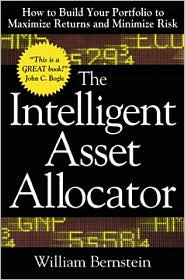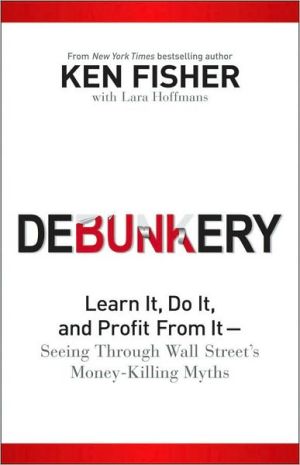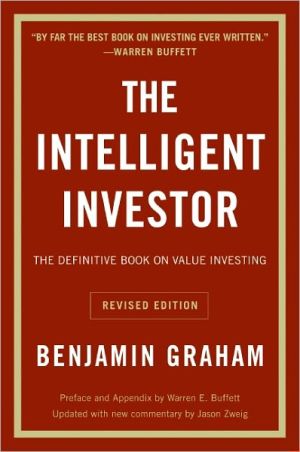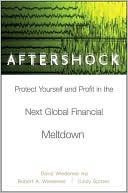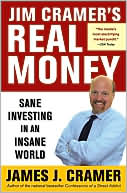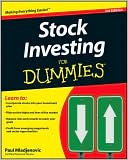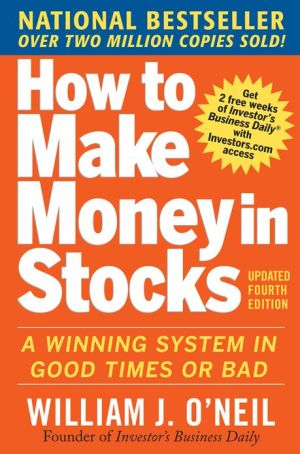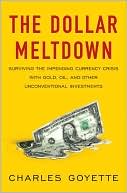The Intelligent Asset Allocator: How to Build Your Portfolio to Maximize Returns and Minimize Risk
“Bernstein has become a guru to a peculiarly ’90s group: well-educated, Internet-powered people intent on investing well—and with minimal ‘help’ from professional Wall Street.”\ —Robert Barker, BusinessWeek\ William Bernstein is one of today’s most unlikely financial heroes. A practicing neurologist, he used his self-taught investment knowledge and research to build a popular investor’s website. Now, in the plain-spoken The Intelligent Asset Allocator, he shows independent investors how to...
Search in google:
Time-Tested Techniques - Safe, Simple, and Proven Effective - for Building Your Own Investment Portfolio."As its title suggest, Bill Bernstein's fine book honors the sensible principles of Benjamin Graham in the Intelligent Investor Bernstein's concepts are sound, his writing crystal clear, and his exposition orderly. Any reader who takes the time and effort to understand his approach to the crucial subject of asset allocation will surely be rewarded with enhanced long-term returns." - John C. Bogle, Founder and former Chief Executive Officer, The Vanguard Group President, Bogle Financial Markets Research Center Author, common Sense on Mutual Funds."Bernstein has become a guru to a peculiarly '90s group: well-educated, Internet-powered people intent on investing well - and with minimal 'help' from professional Wall Street." - Robert Barker, Columnist, BusinessWeek."I go home and tell my wife sometimes, 'I wonder if [Bernstein] doesn't know more than me.' It's humbling." - John Rekenthaler, Research Chief, Morningstar Inc.William Bernstein is an unlikely financial hero. A practicing neurologist, he used his self-taught investment knowledge and research to build one of today's most respected investor's websites. Now, let his plain-spoken The Intelligent Asset Allocator show you how to use the time-honored techniques of asset allocation to build your own pathway to financial security - one that is easy-to-understand, easier-to-apply, and supported by 75 years of solid history and wealth-building results.William Bernstein (North Bend, OR) runs a website—www.efficientfrontier.com—known for its quarterly journal of asset allocation and portfolio theory, Efficient Frontier. BusinessWeek - Robert Barker A practicing neurologist in remote coastal Oregon, Bernstein comes to the problems of saving and investing not from a broker's perspective, but as someone who had to figure this out himself, from first principles up. He introduces readers to an imaginary Uncle Fred, who helps to guide us through lessons in statistics, probability theory, diversification, portfolio management, and the superiority of cheap value stocks over shares in growth companies. None of this is easy, hor does Bernstein treat it that way. But he is refreshingly respectful of our time, packing maximum thinking into minimum pages.
1: General Considerations\ Imagine that you work for your rich but eccentric Uncle Fred. He is a conscientious and kind employer, and after you have spent some years in his service he decides to let you in on the company pension plan. You are 30 years old and will work for your uncle until you retire in 35 years at age 65. Each year he will contribute $5000 to your retirement account. Further, you must pick ahead of time one of two investment choices for the duration of your employment: \ Option 1. Certificates of deposit with a 3% annualized rate of return.\ Option 2. A most peculiar option: At the end of each year Uncle Fred flips a coin. Heads you receive a 30% investment return for that year, tails a minus 10% (loss) for the year. This option will be referred to as "Uncle Fred's coin toss," or simply, the "coin toss."\ \ The first choice gives you a fixed rate of return and, in fact, an absolutely certain lump sum at the end of your 35 years. You are adept with a financial calculator, and in a few seconds you determine that this option will yield a sum of $302,310 with which to support your golden years. You realize that inflation will diminish the future value of this princely sum. In fact, if inflation is also 3%, you will be left with only $107,436 of current spending power.\ The second choice confuses you at first. The thought of losing 10% of your hard-earned retirement money with the toss of a coin is too much to bear. What if you have a string of losing years? If you get tails all 35 years, you could be left with only a pittance for your retirement. On the other hand, if you get heads all 35 years you know that you will bankrupt poorUncle Fred with your gains-he will owe you $162,000,000!\ Let's look a bit more closely at the second choice. Over a long enough period, you will get exactly half heads and half tails. If you represent this with an alternating series of heads and tails, then your return in each two-year period is represented by:\ 1.3 X .9 = 1.17\ The first year return of 30% results in your account being multiplied by 1.3, while a 10% loss multiplies your sum by 0.9. For each dollar you had at the beginning of the two-year period, you now have $1.17.\ You again get out your calculator and find that a 17% return at the end of two years is the same as an annual return of 8.17%. This is clearly superior to the 3% return of the first option. Of course, you could have a string of bad luck and get tails more than half of the time. However, with some trial and error on your calculator, you discover that you would have to get 12 heads and 23 tails before you come out worse than the first option, and you decide that the odds of this are quite low. You visit your former college statistics professor, who chides you for forgetting that you could have easily calculated the odds of any combination of coin flips with the so-called binomial distribution function. Your blank look elicits a sigh from him, he heads over to his computer, pulls up a spreadsheet program, and after a few keystrokes hands you the graph in Figure 1-1. What are the odds that you will flip less than 13 heads and come out behind? Less than 5%. Actually, this is a bit of an oversimplification. The order of the coin tosses matters a great deal. If you toss 16 straight heads then 19 straight tails you will still come out behind, but if you toss 27 straight tails followed by 8 straight heads you will actually come out ahead. However, these are extremely unlikely events, and the preceding formulation and the graph in Figure 1-1 are an accurate representation of the odds in your favor.\ The coin toss also introduces the difference between the average and the annualized return of an asset. Some of you may wonder why the return of the coin toss is not 10% instead of 8.17%, since the average of + 30% and -10% is + 10% (30 minus 10, divided by 2). The average return is simply the average of each of the individual annual returns. The annualized return is a more subtle concept. It is the return that you must earn each and every year to equal the result of your series of differing annual returns. If you own a stock which doubles (has a 100% return) the first year and then loses 50% the next year you have a zero annualized return. If the stock was worth $10 per share at the start, it was worth $20 at the end of the first year, and $10 again at the end of the second year, You have made no money, and yet the average return is a so-called 25% (the average of +100% and -50%). Your annualizes' return is zero. The annualized and average return clearly are not the same. The coin toss has an average return of 10% and an annualized return of 8.17%. The annualized return is always less than the average return. If in the coin toss you come up with half -10% and half +30% returns, this is the same as having an 8.17% return each and every year. You pay your bills with annualized return, not average return. This is why annualized returns are so important...
General Considerations. Risk and Return. The Behavior of Multiple-Asset Portfolios. The Behavior of Real-World Portfolios. Optimal Asset Allocations. Market Efficiency. Odds and Ends. Implementing Your Asset Allocation Strategy. Investment Resources. Appendices.
\ Business WeekA practicing neurologist in remote coastal Oregon, Bernstein comes to the problems of saving and investing not from a broker's perspective, but as someone who had to figure this out himself, from first principles up.\ \ \ \ \ Robert BarkerA practicing neurologist in remote coastal Oregon, Bernstein comes to the problems of saving and investing not from a broker's perspective, but as someone who had to figure this out himself, from first principles up. He introduces readers to an imaginary Uncle Fred, who helps to guide us through lessons in statistics, probability theory, diversification, portfolio management, and the superiority of cheap value stocks over shares in growth companies. None of this is easy, hor does Bernstein treat it that way. But he is refreshingly respectful of our time, packing maximum thinking into minimum pages. \ — BusinessWeek\ \
